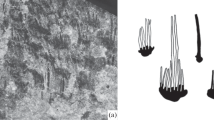Abstract
Of the recent sauropsid skin appendage types, only feathers develop from a cylindrical epidermal invagination, the follicle, and show hierarchical branching. Fossilized integuments of Mesozoic diapsids have been interpreted as follicular and potential feather homologues, an idea particularly controversially discussed for the elongate dorsal skin projections of the small diapsid Longisquama insignis from the Triassic of Kyrgyzstan. Based on new finds and their comparison with the type material, we show that Longisquama’s appendages consist of a single-branched internal frame enclosed by a flexible outer membrane. Not supporting a categorization either as feathers or as scales, our analysis demonstrates that the Longisquama appendages formed in a two-stage, feather-like developmental process, representing an unusual early example for the evolutionary plasticity of sauropsid integument.




Similar content being viewed by others
References
Chuong C-M, Ping W, Zhang F-C, Xu X, Yu M, Widelitz RB, Jiang T-X, Hou L (2003) Adaptation to the sky: defining the feather with integument fossils from mesozoic China and experimental evidence from molecular laboratories. J Exp Zool 298B:42–56
Harris MP, Williamson S, Fallon JF, Meinhardt H, Prum RO (2005) Molecular evidence for an activator–inhibitor mechanism in development of embryonic feather branching. Proc Natl Acad Sci USA 102:11734–11739
Haubold H, Buffetaut E (1987) A new interpretation of Longisquama insignis, an enigmatic reptile from the upper triassic of Central Asia. C R Acad Sci Ser 2 305:65–70
Ji Q, Yuan C (2002) Discovery of two kinds of protofeathered pterosaurs in the Mesozoic Daohugou Biota in the Ningcheng Region and its stratigraphic and biologic significances. Geol Rev 48:221–224
Jones TD, Ruben JA, Martin LD, Kurochkin EN, Feduccia A, Maderson PFA, Hillenius WJ, Geist NR, Alifanov V (2000) Nonavian feathers in a late triassic archosaur. Science 288:2202–2205
Lucas AM, Stettenheim PR (1972) Avian anatomy: integument. US Dept. Agriculture, Washington, DC
Martin LD (2004) A basal archosaurian origin of birds. Acta Zool Sin 50:978–990
Mayr G, Peters SD, Plodowski G, Vogel O (2002) Bristle-like integumentary structures at the tail of the horned dinosaur Psittacosaurus. Naturwissenschaften 89:361–365
Prum RO (1999) Development and evolutionary origin of feathers. J Exp Zool 285B:291–306
Prum RO (2001) Longisquama fossil and feather morphology. Science 291:1899–1900
Prum RO, Brush AH (2002) The evolutionary origin and diversification of feathers. Q Rev Biol 77:261–295
Reisz RR, Sues H-D (2000) Palaeontology: The ‘feathers’ of Longisquama. Nature 408:428
Schaller S (1985) Wing evolution. In: Hecht MK, Ostrom JH, Viohl G, Wellnhofer P (eds) The beginnings of birds. Freunde des Jura-Museums, Eichstätt, pp 333–348
Schaumberg G, Unwin DM, Brandt S (2007) New information on the anatomy of the late Permian gliding reptile Coelurosauravus. Palaeont Z 81:160–173
Senter P (2004) Phylogeny of Drepanosauridae (Reptilia: Diapsida). J Syst Palaeontol 2:257–268
Sharov AG (1970) A specific reptile from the Lower Triassic of Fergana. Paleontol Z 1970:127–130 (in Russian)
Unwin DM, Benton MJ (2001) Longisquama fossil and feather morphology. Science 291:1900–1901
Unwin DM, Alifanov VR, Benton MJ (2000) Enigmatic small reptiles from the middle-late Triassic of Kirgizstan. In: Benton MJ, Shishkin MA, Unwin DM, Kurochkin EN (eds) The age of dinosaurs in Russia and Mongolia. Cambridge University Press, Cambridge, pp 177–186
Wang X, Zhou Z, Zhang F, Xu X (2002) A nearly completely articulated rhamphorhynchoid pterosaur with exceptionally well-preserved wing membranes and “hairs” from Inner Mongolia, northeast China. Chin Sci Bull 47:226–230
Widelitz RB, Jiang TX, Yu M, Shen T, Shen J-Y, Wu P, Yu Z, Chuong C-M (2003) Molecular biology of feather morphogenesis: a testable model for Evo-Devo research. J Exp Zool 298B:109–122
Wu P, Hou L, Plikus M, Hughes M, Scehnet J, Suksaweang S, Widelitz RB, Jiang T-X, Chuong C-M (2004) Evo-devo of amniote integuments and appendages. Int J Dev Biol 48:249–270
Yu M, Wu P, Widelitz RB, Chuong CM (2002) The morphogenesis of feathers. Nature 420:308–312
Yu M, Yue Z, Wu P, Wu D-Y, Mayer J-A, Medina M, Widelitz RB, Jiang T-X, Chuong C-M (2004) The developmental biology of feather follicles. Int J Dev Biol 48:181–191
Yue Z, Jiang T-X, Widelitz RB, Chuong CM (2005) Mapping stem cell activities in the feather follicle. Nature 438:1026–1029
Yue Z, Jiang T-X, Widelitz RB, Chuong C-M (2006) Wnt3a gradient converts radial to bilateral feather symmetry via topological arrangement of epithelia. Proc Natl Acad Sci USA 103:951–955
Acknowledgements
This work was supported by the German Research Foundation (DFG II - VO 1466/1–1) and by the Society of Vertebrate Paleontology (Patterson Memorial Grant to JF). We are thankful to Evgenii N. Kurochkin and Vladimir R. Alifanov for access to the type material in Moscow in February 2007, to Susan Turner and Jörg W. Schneider for suggestions and comments, and to Ilja Kogan for his help with the translation of Russian publications and reports.
Author information
Authors and Affiliations
Corresponding author
Additional information
Communicated by G. Mayr
Electronic supplementary material
Below is the link to the electronic supplementary material.
Electronic supplementary material S1
Complete data table. (XLS 115 KB)
Electronic supplementary material S2
Table of data displayed in Fig. 2b. (XLS 79.5 KB)
Electronic supplementary material S3
Multivariate analysis. (XLS 84.0 KB)
Rights and permissions
About this article
Cite this article
Voigt, S., Buchwitz, M., Fischer, J. et al. Feather-like development of Triassic diapsid skin appendages. Naturwissenschaften 96, 81–86 (2009). https://doi.org/10.1007/s00114-008-0453-1
Received:
Revised:
Accepted:
Published:
Issue Date:
DOI: https://doi.org/10.1007/s00114-008-0453-1



